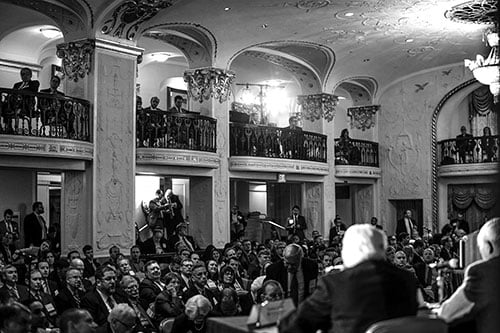Facts of the Case
The Fourteenth Amendment protects every person's right to due process of law. The Fifteenth Amendment protects citizens from having their right to vote abridged or denied due to "race, color, or previous condition of servitude." The Tenth Amendment reserves all rights not granted to the federal government to the individual states. Article Four of the Constitution guarantees the right of self-government for each state.
The Voting Rights Act of 1965 was enacted as a response to the nearly century-long history of voting discrimination. Section 5 prohibits eligible districts from enacting changes to their election laws and procedures without gaining official authorization. Section 4(b) defines the eligible districts as ones that had a voting test in place as of November 1, 1964 and less than 50% turnout for the 1964 presidential election. Such districts must prove to the Attorney General or a three-judge panel of a Washington, D.C. district court that the change "neither has the purpose nor will have the effect" of negatively impacting any individual's right to vote based on race or minority status. Section 5 was originally enacted for five years, but has been continually renewed since that time.
Shelby County, Alabama, filed suit in district court and sought both a declaratory judgment that Section 5 and Section 4(b) are unconstitutional and a permanent injunction against their enforcement. The district court upheld the constitutionality of the Sections and granted summary judgment for the Attorney General. The U.S. Court of Appeals for the District of Columbia Circuit held that Congress did not exceed its powers by reauthorizing Section 5 and that Section 4(b) is still relevant to the issue of voting discrimination.
Questions
Does the renewal of Section 5 of the Voter Rights Act under the constraints of Section 4(b) exceed Congress' authority under the Fourteenth and Fifteenth Amendments, and therefore violate the Tenth Amendment and Article Four of the Constitution?
Conclusions
-
Yes, Section 4 of the Voting Rights Act is unconstitutional. Chief Justice John G. Roberts, Jr. delivered the opinion of the 5-4 majority. The Court held that Section 4 of the Voting Rights Act imposes current burdens that are no longer responsive to the current conditions in the voting districts in question. Although the constraints this section places on specific states made sense in the 1960s and 1970s, they do not any longer and now represent an unconstitutional violation of the power to regulate elections that the Constitution reserves for the states. The Court also held that the formula for determining whether changes to a state's voting procedure should be federally reviewed is now outdated and does not reflect the changes that have occurred in the last 50 years in narrowing the voting turnout gap in the states in question.
In his concurring opinion, Justice Clarence Thomas argued that Section 5 of the Voting Rights Act is unconstitutional in addition to Section 4. He wrote that the blatant discrimination against certain voters that Section 5 was intended to prohibit is no longer evident. Without such extraordinary circumstances, Congress cannot constitutionally justify placing the burden of Section 5 on the states in question.
Justice Ruth Bader Ginsburg wrote a dissent in which she argued that Congress' power to enforce the Fourteenth and Fifteenth Amendments encompasses legislative action such as the Voting Rights Act. The legislative history and text of the Amendments as well as previous judicial precedent support Congress' authority to enact legislation that specifically targets potential state abuses. However, Congress does not have unlimited authority but must show that the means taken rationally advance a legitimate objective, as is the case with the Voting Rights Act. The evidence Congress gathered to determine whether to renew the Voting Rights Act sufficiently proved that there was still a current need to justify the burdens placed on the states in question. She also argued that, by holding Section 4 unconstitutional, the majority's opinion makes it impossible to effectively enforce Section 5. Justice Stephen G. Breyer, Justice Sonia Sotomayor, and Justice Elena Kagan joined in the dissent.
Shelby County, Alabama v. Holder: Must Congress Update the Voting Rights Act’s Coverage Formula for Preclearance?
Engage Volume 14, Issue 1 February 2013
Section 5 of the Voting Rights Act requires “covered jurisdictions”—mostly, but not exclusively, in the...
Testimony on “The Voting Rights Act after the Supreme Court’s Decision in Shelby County”
Engage Volume 14, Issue 2 July 2013
Note from the Editor: This article is based on testimony given by the author before...
The Voting Rights Act in the Supreme Court: Shelby County v. Holder - Podcast
Civil Rights Practice Group Podcast
On Wednesday, February 27, the U.S. Supreme Court heard oral arguments in Shelby County v. Holder....
Shelby County v. Holder - Post-Decision SCOTUScast
SCOTUScast 7-8-13 featuring Abigail Thernstrom
On June 25, 2013, the Supreme Court announced its decision in Shelby County v. Holder....
Shelby County v. Holder - Post-Argument SCOTUScast
SCOTUScast 2-27-13 featuring Michael Carvin
On February 27, 2013, the Supreme Court heard oral argument in Shelby County v. Holder. The...
The Supreme Court in Crisis: A Good Read, But No Crisis
Federalist Society Review, Volume 19
A review of: American Justice 2017: The Supreme Court in Crisis, by Kimberly Robinson (University...
Hate Crimes and the Thirteenth Amendment
Hate crimes are abhorrent to all decent persons. But does Congress have the power to...
Texas State Bar Racial and Gender Quotas Head to Court
In a recent ad, the State Bar of Texas announced that it is accepting applications for...
Harris v. Arizona Independent Redistricting Commission - Post-Argument SCOTUScast
SCOTUScast 2-11-16 featuring Mark F. Hearne II
On December 8, 2015, the Supreme Court heard oral argument in Harris v. Arizona Independent...
Is Section 5 of the Voting Rights Act Constitutional? - Podcast
Civil Rights Practice Group Podcast
To listen, please right click on the audio file you wish to hear and then...
2015 ABA Annual Meeting Report: Programming
From July 30th to August 4th, the American Bar Association met in Chicago for its...
Sleeping Giant?: Section Two of the Thirteenth Amendment, Hate Crimes Legislation, and Academia’s Favorite New Vehicle for the Expansion of Federal Power
Engage Volume 13, Issue 3 October 2012
A brief look at the Thirteenth Amendment might suggest that it has rather limited application...
2021 National Lawyers Convention
Public and Private Power: Preserving Freedom or Preventing Harm?
The Mayflower Hotel1127 Connecticut Avenue, NW
Washington, DC 20036
Courthouse Steps Decision Webinar: Brnovich v. Democratic National Convention
Free Speech & Election Law Practice Group Teleforum
TeleforumShelby County v. Holder Five Years Later
Ohio Northern Student Chapter
Tilton Hall of Law415 S. Gilbert Street
Ada, OH 45810
Civil Rights in the United States
Sponsored by the Federalist Society's Civil Rights Practice Group, the Cato Institute, and the Heritage Foundation
The Mayflower Hotel1127 Connecticut Avenue, N.W.
Washington, DC 20036













